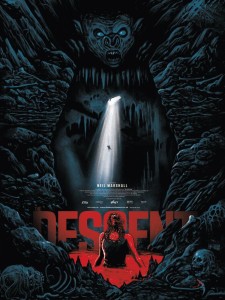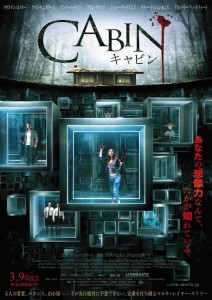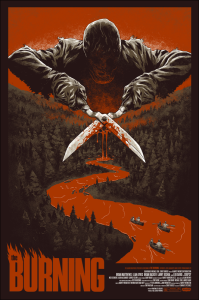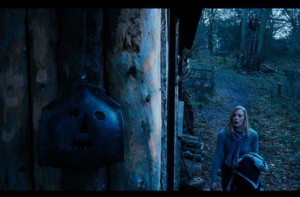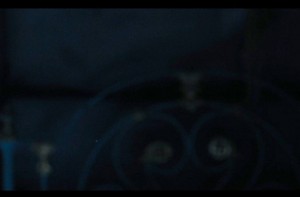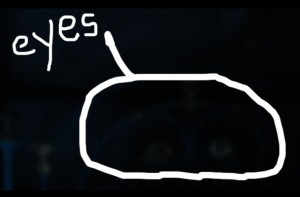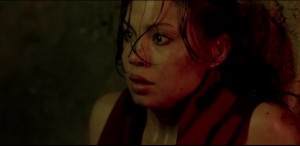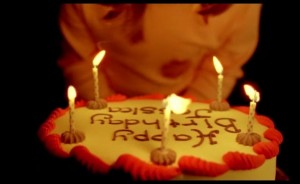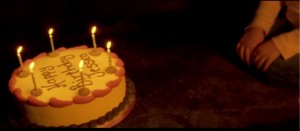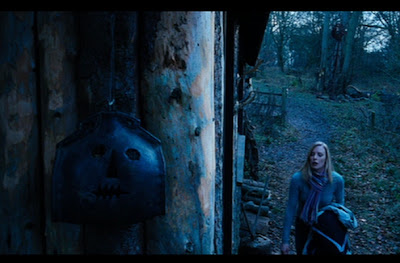





Shocktember/Rocktober
It’s that amazing time of year again when the leaves start to turn, the weather starts to change, Saturdays are for football – well, at least the last one is true in the South. But the best part about the fall is being able to watch fantastic scary movies (no bad ones!) during the months of September and October. I’ve written about Rocktober before, but I wanted to clarify what makes a Shocktember movie and what makes a Rocktober movie, and everything in-between.
Few things in life are more important than understanding the difference between a Shocktember movie and a Rocktober movie. Don’t think so? Let me ask you this, hotshot – would you watch Halloween the first week in September, like some kind of animal? Exactly. So I’m here to explain how to categorize these films.
First and foremost, here is the Shocktember.Rocktober.Master.List, which includes movie times so you can fit some of the shorter movies in on a weeknight.
SHOCKTEMBER
Shocktember movies basically fall into two categories: Creatures and zombies. I don’t want to get into a huge debate about it, but yes, I consider the infected souls in 28 Days Later/28 Weeks Later to be zombies. Other than that, Shocktember encompasses any creature unusual in origin, size, number, or ferocity. Some standouts include:
The Descent: Duh. I’ve written about The Descent a lot (here and here, and I’ll probably be writing another entry soon), but only because it’s absolutely, completely brilliant. Following a tragedy, five women get trapped underground in a cave, only to find out they’re not alone. I consider this to be the best horror movie ever made, and the creatures don’t even show up until 47 minutes into the film.
Black Water: While Rogue (another crocodile movie also on the list) is more action/horror, Black Water is suspense/horror. Both are great, but unlike the raucous ending of Rogue, Black Water keeps everything relatively grounded. The story is simple: Three individuals on a crocodile tour get trapped in a mangrove tree out in the middle of nowhere, with a crocodile trying to kill them. It is wonderful.
The Ruins: This is one where you either buy into the premise (which is admittedly far-fetched) or you do not. I do. Trapped in the jungle on top of ancient ruins (hey!), five friends have to try and survive while something is trying desperately to kill them.
Don’t you forget about: 28 Days Later, Rogue, Shrooms, Last Winter
“CUSP MOVIES”
“Cusp movies” (a term coined by my excellent wife Claire) are horror movie films with a sense of humor; an homage to the genre. These movies have an awareness of what makes a horror film, and they generally mix humor with suspense. They’re called cusp movies because they need to be watched during the last week of Shocktember and the first week of Rocktober. Some standouts include:
Cabin in the Woods: I don’t know about it being the “best horror movie of the 21st century,” but only because The Descent exists. It is absolutely brilliant, chock full of horror movie references while simultaneously explaining, skewering, and embracing the entire genre.
Behind the Mask: The Rise of Leslie Vernon: Set up as a horror movie documentary where student journalists interview a killer, the movie is a delightful, clever feature that does a great job of explaining the structure of a horror movie. The script is brilliant, but Nathan Baesel’s performance carries the movie.
Tucker and Dale vs. Evil: It’s a funny, smart case of mistaken identity with two actors who escalate the (already excellent) material to an underrated film.
Don’t you forget about: Severance, Dog Soldiers
ROCKTOBER
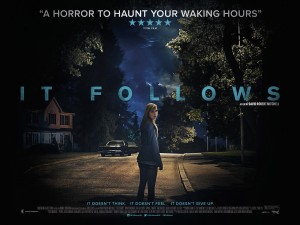 Rocktober movies can basically be boiled down into two concepts: Slashers and the supernatural. This is where you get a lot of your classic psycho-murderer films, so no point in listen the staples (Halloween, Friday the 13th, etc.). I wrote about some Rocktober movies you shouldn’t miss, but here are a few standouts that you should definitely check out.
Rocktober movies can basically be boiled down into two concepts: Slashers and the supernatural. This is where you get a lot of your classic psycho-murderer films, so no point in listen the staples (Halloween, Friday the 13th, etc.). I wrote about some Rocktober movies you shouldn’t miss, but here are a few standouts that you should definitely check out.
It Follows: When one of the best TV/film critics around says it’s the “scariest American horror movie in years,” you should set your expectations accordingly. The film is uncomfortable, unrelenting, and a wonderful allegory for how we think about sex in this country.
The Babadook: Remember when Todd VanDerWerff said that It Follows was the scariest American horror movie in years? Yeah, that’s because The Babadook exists. An Australian horror movie, this film gets inside your head. It’s legitimately creepy, and builds suspense like few movies can.
House of the Devil: Watch this movie. Watch this movie. Watch this movie. Released in 2012, this horror film takes place in the 1980s, and…wow. It feels like the entire thing was shot in 1986 and they just found the footage a few years ago. All you need to know is that it involves devil worship, a babysitter, and incredible suspense.
Don’t you forget about: Halloween (duh-doy), Night of the Demon, Trick R Treat, Paranormal Activity, House of Wax
BACKGROUND
The weekend is a great time to catch up on horror movies, but let’s face it: sometimes you’ve got stuff to do! This is where the background movies come in. Generally speaking, background movies (like Troy, any Rambo film, Inside Man, etc.) are films designed to be watched while you’re doing something else. A great background movie is entertaining, but not too entertaining – something where you can look up every once in a while to watch a scene, but you don’t have to stare at the screen. The main rules: Nothing too intense/interesting, and no subtitles.
It’s no different for horror movies. Here are a few standouts that don’t stand out too much:
The Burning: Released after Friday the 13th, even if you’ve never seen this movie before…you’ve seen this movie before. It hits all the beats of a slasher film because it was one of the first. After an incident at summer camp, a maniac returns to exact revenge (sound familiar?). The deaths are creative, the killer is actually a bit sympathetic, and it features a very young George Costanza.
Friday the 13th – Part III: Speaking of Friday the 13th…yeah. The fact that this entry in the film was ranked 9th (!!!) in the series is inexcusable. It’s an absolute blast. The acting is horrible, the storyline is muddled, and the subplots are bizarre. But every once in a while, you look up just in time to see a blatant example of 3-D filmmaking (the axe is comin’ right at you!). It’s a perfect background horror movie.
Joy Ride: Until things totally fly off the rails at the very end (which is still wildly entertaining), this movie is way better than it should be. This makes for a great background feature because you can look up every once in a while for an fun sequence, and you can look back down before thinking, “Wait a minute…” Incidentally, if you ever get ahold of the dvd like some kind of dinosaur, there are four alternate endings (and the one in the cornfield is actually better than the version that appears on-screen). Just make sure one of the times you look up is when Walker and Zahn are in the hotel room – that scene belongs in a much better movie.
Don’t you forget about: Wrong Turn, Scream, Psycho
EXCEPTIONS
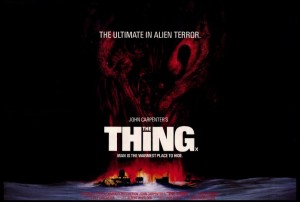 It’s like I always tell my visual communication students: You can break any design rule you want, just make sure you have a very good reason for it.
It’s like I always tell my visual communication students: You can break any design rule you want, just make sure you have a very good reason for it.
The tricky part about Shocktember/Rocktober is that there really isn’t a place for science fiction films. I love Time Crimes more than most (because it’s an amazing film), but it’s not a fit for fall.
Having said that, there are two movies that I make room for in the movie schedule:
The Thing: This John Carpenter film is timeless, thanks to its claustrophobic atmosphere and practical special effects. While it’s technically sci-fi/horror (the Thing is an alien), quite frankly, it’s too good not to have in the rotation.
Alien: Speaking of too good to exclude, this film has it all. It’s majestic, it’s suspenseful, it’s innovative, it’s exciting – I just have to watch it. No need to watch the director’s cut, as Ridley Scott actually said the only reason he released that format was so it could be released on the big screen again. Having said that, the director’s cut of Aliens actually provides a lot of important exposition that really enhances the story. Now you know.
Congratulations, now you’re ready to embrace these two months of glory.
Whatever you choose to watch, make sure to use this amazing Spiced.Apple.Cider recipe! Let it simmer in the crockpot all day, and pair with a hot bowl of chili.
Now get moving – you have a lot of work to do.

Rocktober
Not having the autumn around can be tough. The leaves don’t really change in Texas, nor does the weather (except for an errant haboob every now and then). But I know that the fall has truly arrived when Rocktober starts. What is Rocktober? Great question!
Rocktober is an annual tradition where my wife and I watch as many quality scary movies as possible during the month of October. And it rocks!
Now, this isn’t a competition. We have a list of movies we try to get through, but it doesn’t always work. Stuff happens. Deadlines, grading, the Community Halloween episode–if we don’t get to all the films, there’s always next year (or, for some, next month–The Orphanage is always good).
So what do you need? Only three things.
1) Nighttime. The Birds and Scream should be the only scary movies you should watch during the day. The rest of the year you have plenty of time for other movies. Make time for Rocktober.
2) Apple cider. If you can, find a great recipe (start with real cider, not that apple juice they market as cider at the grocery store), and let that beast simmer in the crockpot. If you need a recipe, here’s the one we use:
• 8 cups apple cider
• 1/4 – 1/2 cup of brown sugar
• 6 inches of stick cinnamon
• 1 tsp whole allspice
• 1 tsp. whole cloves
Put the dry materials in a spice bag, and enjoy.
3) The movies. For all of you who want to play along at home, here is the list of films. Unfortunately, I do draw the line at some films. For example, I like having zombies represented on the list (Night of the Living Dead), but I don’t want to spend the entire month on them (especially those that *technically* aren’t true zombie movies, such as 28 Days Later). As for pretty much everything else, it’s just a matter of preference. Add or take away what you wish.
I would, however, like to mention three specific movies that you might want to be sure to include. You don’t need me to tell you that Halloween is a masterpiece, or that The Thing is one of the greatest horror films of all time. And by now I’m sure you know of my unmatched adoration for The Descent (you should–I talked about it here…and here too). But here are three that you might have overlooked:
Trick ‘R’ Treat: This one was actually not even released in theaters, but it should be a permanent addition to your Halloween line-up. I actually watch it the day before Halloween (both the day and the movie). It’s a series of four stories, all taking place on Halloween. It’s dark, but has dark humor. It’s very aware of its audience, but doesn’t mug for the camera. It doesn’t take itself too seriously, but has some genuinely scary moments. Oh, and it features (among others) Anna Paquin and Brian Cox. Show your friends–you’ll look like a genius.
Night of the Demon: It’s strange that when I talk about horror classics, I tend to forget about everything pre-1978. Night of the Demon was released in 1957 and it stars Dana Andrews as a scientist who debunks the supernatural, but is faced with a series of mysterious deaths (think the premise of The Reaping but without the heavy-handed religious message. And the horrible ending. And the awful pacing. On second thought, don’t think of The Reaping.). The plot might not sound like anything impressive, but the acting and the atmosphere make for a truly unsettling film (without any gore).
House of Wax: Yes, the original is a classic, but I am more and more impressed by the remake each time I watch it. Yes, I am aware that the critics do not feel the same way I do. But here’s my take: House of Wax is the complete opposite of the modern horror film because it starts off horribly but gets better and better. I realize that the film was basically a vehicle to see Paris Hilton killed off, but after the first 20 minutes of what can laughably be called character development, the plot really takes off and there are some great scenes. Rocktober is a 31 day event–you’ve got time.
Here is the list, in no particular order. Enjoy.
HALLOWEEN WEEK:
– Halloween
– Trick R Treat
– Friday the 13th
– The Shining
– Nightmare on Elm Street
TO WATCH:
– The Ring
– Isolation
– The Orphanage
– Severance
– Vacancy
– Blair Witch Project
– Poltergeist
– House of Wax
– The Changeling
– The Thing
– The Orphan
– Let Me In
– Behind the Mask
– The Mist
– Dog Soldiers
– Last Winter
– Psycho
– Paranormal Activity
– Shrooms
– Night of the Living Dead
– Night of the Demon
– The Omen
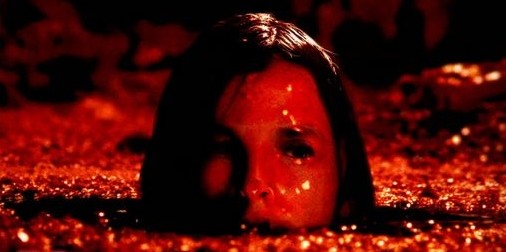
Solving The Descent
Yes, I will continue to analyze this movie because it is absolute genius. And yes, this entry is designed for people who have seen this movie before–spoilers galore.
As I said, I have analyzed this movie before, and I have written pages and pages on The Descent. But I cannot stop until I solve the mystery. Again, enough cannot be said about this film. Nothing is wasted in this film – every line of dialogue has a purpose and every shot is necessary. The characters themselves are rich and this is one of the very few films to feature a nearly all-female cast (typically the closest thing Hollywood comes to an all-female cast is The Women). Let’s say, for the sake of argument, that for a character to count, (s)he has to speak at least three lines of dialogue. By that definition, this cast is comprised solely of women. But can you think of any others? By that same definition, an all-male cast is relatively easy to find: The Dirty Dozen, The Great Escape, First Blood, Patton, Shawshank Redemption… That’s just one of the many things that makes this film so unique.
Of course, what’s perhaps most interesting (as we’ve discussed before) is what truly happened in this film. Last time we talked about the possibility of Sarah being in the hospital and dreaming everything, the possibility that she murdered everyone, and the possibility that she remained trapped in the cave.
Let’s discuss this further.
After the bitchin’ car wreck, Sarah wakes up in the hospital, attached to a variety of machines. She pulls the sensors off of herself and the camera focuses on the heart monitor, which reads as a flatline (naturally, since she removed the indicators). Then things get really interesting. Sarah walks out into the deserted hallway and turns around in time to see the lights turning off, slowly overtaking her as she runs away. Darkness, as we will see, plays a key role throughout the movie.
I think you can make a decent argument that Sarah never actually leaves the hospital room. She remains in a coma and the crawlers slowly kill off her friends (which represent part of her psyche) until none remain and she dies right there.
Her friends could easily represent her psyche–just look at the roster:
Beth – Loyalty, friendship
Sam – Innocence
Juno – Adventure (or “the id”)
Rebecca – Responsibility
Holly – Sexuality (could easily be adventure as well)
But, to me anyway, the idea that it was all in her head feels like a cop-out of a movie–while we’re making it “all just a dream,” why don’t we hit on all the cliches and give some character amnesia. Brilliant!
No, The Descent deserves better than that.
I believe that Sarah did leave the hospital room and, a year later, she was reunited with her friends. Then, during a caving expedition, they were trapped, she slowly went insane, and savagely murdered everyone in the group.
As any good horror movie would do, this is hinted at in the dialogue. Early on, Rebecca warns that down in the caves, “you can get dehydration, disorientation, claustrophobia, panic attacks, paranoia, hallucinations, visual and aural deterioration.” When Sarah first sees a crawler, Juno is frantic in trying to convince that it’s Sarah’s eyes that are playing tricks on her.
Furthermore, watch Juno whenever she sees Sarah near the end of the film – Juno is clearly terrified.
The most damning piece of evidence occurs at precisely 1 hour 20 minutes into the movie. Sarah has just been born again hard, emerging from the pool of blood and ramming a horn into a lady crawler’s head before braining another crawler with a gigantic bone. Victorious, she stands on a rock with her torch in hand, takes a deep breath, and screams as loudly as she can. The film then cuts to Juno, Sam, and Rebecca who are startled by the scream. However, this is where it gets nuts. The scream is NOT Sarah’s, at least not the one they hear. The scream is continuous, but as soon as the shot cuts from Sarah to the remaining members of the group, it changes into the screech of the crawlers.
In case you couldn’t follow that, here’s the video clip:
So, if I’m correct, the group is trapped by a cave-in, which pushes Sarah over the edge. Driven mad by the situation, by the darkness (which the girls warned about), and the death of her family, Sarah kills her friends before settling down to die underground (either by her own hand or by the elements over time).
This is where the faces come into play. Remember talking about the faces? They’re everywhere in the movie. Some are obvious examples:
While others are less obvious (like the eyes hiding behind Sarah when she awakens from a nightmare in the cabin:
See the eyes?
These shots bothered me to no end, because I couldn’t figure out what the faces represented. This last time watching it, I realized that it wasn’t about faces; it was about the eyes. The eyes represent a point of view, a way of explaining to the viewer through whose lens we’re watching the events unfold. I argue that, after Sarah goes insane, we (the audience) start seeing the events through two different points of views: Sarah’s and everyone else’s.
Every time we cut to shots of the crawlers attacking the other women in the group (Juno et al.), that’s Sarah’s warped vision of what’s going on–her mind’s coping mechanism for understanding what’s happened to her friends. Every time Sarah enters the shot, the viewpoint switches.
Don’t believe me? Look at the utter horror on Juno’s face when she sees Sarah for the first time since hearing her scream:
Throw in the fact that Sarah spends the last part of the film covered in blood, and the fact that we see Sarah kill Beth and Juno, and I feel like this “mystery crawlers” theory has some merit. Sure, we see the crawlers when she’s fighting with Juno, but, no damage is done to either woman. It’s the confrontation between those two women afterward that determines Juno’s fate.
Another reason that Sarah may have been killing people was because of her daughter. What? Yes. Her daughter.
What I noticed the most this time was the constant presence of the image of Sarah’s daughter. In the film, there are no fewer than four shots of Sarah’s daughter (after the girl has died) holding a birthday cake (they had spoken of her upcoming birthday in the car). She only appears when Sarah is unconscious, most of the time after falling and hitting her head. Specifically, these occur when Sarah is in the hospital, after Sarah is almost trapped in the tunnel, after she falls into the pit (before seeing Holly), and at the end of the film. There is also another spot after Holly breaks her leg where Sarah hears her daughter’s laughter and pursues the sound (this is the first time she sees a crawler)–not technically a sighting, but the daughter was involved.
In one intriguing shot (after Sarah runs away from the alleged crawler, falls down, and hits her head), she has another vision of her daughter. But, as you can see, her daughter literally transforms into a crawler:
Assuming the daughter is a representation of Sarah’s psyche, this might be a marker for when her mind split.
Now, the other times we see the daughter, young Jessica is blowing out the candles on a birthday cake. Here is a screen shot of the cake flashback:
Notice the five candles? How about the five friends? This film is far too good for that to be a coincidence. Especially given the last shot. Prepare to have your mind blown.
And here is a shot of the cake that appears at the end of the film. Notice anything different?
Six candles! BOOM!
So what’s the significance? For me, I think it goes back to the basics. Before you blow out your birthday candles, you make a wish. I think that, in Sarah’s mind, her daughter (Jessie) was wishing to be reunited with her mom. In order for that to come true, the candles all had to be blown out. There were five candles, and each represented one of her friends. One by one, Sarah snuffed out those candles by killing her friends. In the last shot, there were six candles. As Sarah sits across from the image of her daughter, you can hear the crawlers screeching in the background. The sixth candle is Sarah (evidenced by the fact that she is the only one carrying around a torch), and she’s about to kill herself to finally be with her daughter.
We assume these shots are interrupting the film. Could it be that, as far as Sarah is concerned, the movie is interrupting these shots? She needs to get rid of her friends in order to be with her daughter. This would suggest that her friends were either killed off in her mind or that Sarah literally killed them all in the cave.
Again, this is an interpretation, not the interpretation, but it’s one that I think is worthy of this film. What a masterpiece.
“Scary” Movies
I’m not going to go on a rant about how horrible horror movies are these days–I’m not that old. More importantly, no era is impervious to criticism–for every Halloween there are 50 Kingdom of the Spiders.
That said, it seems that recent horror movies have glommed onto certain ideas about how to scare audiences, and those ideas are failing miserably. The Unborn, A Haunting in Connecticut, One Missed Call…the list of suck just goes on and on.
I think the underlying problem is that the writers and directors of these films have confused “scary” and “startled.” Being startled happens when something occurs on-screen that surprises you: someone appears in a mirror or behind a door, a dark shape moves across the background accompanied by a loud blurt from the soundtrack, or a human-like figure is shown with unusual attributes.
I’m going to geek out for like a paragraph or so. Children go through three different stages in terms of fear. From ages 3-8, kids are frightened of unrealistic, fanciful stimuli, such as monsters, mutants, or supernatural creatures; in other words, things that do not typically appear in the world. From ages 9-12 (of course, these ages are approximate and are not steadfast for everyone), children are scared of more realistic stimuli in the form of bad things (murder, abduction) that could happen to them or loved ones. Children ages 13 and over scared of more abstract stimuli, typically on the psychological level. They’re scared of physical harm as well, but overall their concerns have spread to include people everywhere. In short, the progression goes from discomfort of the initial image to a deeper fear of something bad happening to anyone, including strangers.
Looking at these recent films, it’s easy to see that they’re only accessing that first level of fear, which is normally restricted to young children. Those disturbing images of malformed victims don’t frighten adults–they startle adults. But, the more those images are on the screen, the more time our brains have to work on figuring out why this individual doesn’t look like others. The most logical conclusion (which is also most-easily reached) is that the image is fake. And, suddenly, the movie isn’t scary, just annoying and insulting.
So here are my random thoughts for scary movie filmmakers(albeit incomplete and jumbled) on how to fix the horror genre:
1) Develop tension. Seriously, it’s actually not that hard. Create a character that’s moderately likable (hell, sometimes it doesn’t even take that) and build some tension. Give us viewers some information that the characters do not have. Let us see the person lurking in the background (as opposed to a loud musical screech as a shadow rushes by in the background). Take your time. Slowly pan the camera around slowly. Let us see that something in the room has changed. Subtly give us a clue instead of beating us over the head with the obvious.
2) Enough with the mirrors. We get it–the character looks down to wash her face, she looks back up and OMG THERE’S A PERSON IN THE MIRROR!!!11!!1!!1! Yeah, you’re not even trying anymore. At least, if you do it, have the guts to play with the audience a little bit (like in the underrated Orphan).
3) Technology still exists. At some point, a meeting was held with all of the horror movie producers and directors to address the fact that it’s not 1999 anymore and everyone now has cell phones (including potential victims in the films). Unfortunately, the meeting lasted only 12 seconds, which was just enough time for someone to blurt out, “Yeah, sure, but what if they lost service?” and for everyone else to agree on the genius fix. Seriously, the “no service” solution has to be the laziest script remedy since amnesia. Unless you’re in the middle of Montana with a Zach Morris cell phone, you can get service. Period. You’re being ridiculous and you’re embarrassing yourself. Find a way to adjust.
4) Nicholas Cage sucks. Nothing to do with horror movies. I’m just saying.
5) Enough with the CGI. Did you learn any lessons from The Haunting? When you use CGI, it doesn’t look real. Period. And, if you start out the horror movie with CGI, most directors use the effects more and more as the movie continues, often building to some sort of epic tornado of suck, like if Carlos Mencia and Tyler Perry were hanging out at Nickelback concert. So, while the CGI effects were a bit bothersome, they become so annoying that you end up resenting the movie.
6) Kids aren’t scary. With very exceptions, kids are not scary. Giving them a bowl cut and slapping on some mascara doesn’t make them scary any more than having an old lady swearing in a movie makes it funny.
There are plenty more, but this should get you started. Work on it, Hollywood.
Stranger Danger
As evidenced by my lengthy discussion of The Descent, I love a good horror movie. There’s something about the creepiness and the ability to tap into fears effectively really fascinates me, and I’m always on the lookout for a good, underrated horror film (I’m looking at you Isolation and Vacancy). In that ongoing quest, Claire and I checked out The Strangers this past weekend, a movie I had seen advertised and, from the look of the trailer, had really strong potential. Jared was not a fan, but what does he know?
Apparently, a lot.
Strangers starts out with the claim, “inspired by true events.” Now normally this is a phrase reserved for Lifetime Original Movies or some Disney knockoff, but when you drop those words on a horror filmwellthat means something. Or at least I thought it did.
The movie’s premise is that a couple has just made it back to a house in the country after attending a wedding, only to be terrorized by strangers (Hey! Just like the title!) for no apparent reason. The first 30 minutes or so had great potential—the couple was dealing with a marriage proposal rejection (Hello worst nightmare, what are you doing in this movie?) and the setup for the scary moments was definitely effective. But what I liked most was that the director went to great lengths to kind of lay out evidence (presumably like a crime scene)—the discarded engagement ring, bloody knife, shattered car window. They even started with a 911 call about finding the bodies. It was a lot of fun trying to figure out how the police pieced together the series of events in real life.
Well, the last half hour got to be a little much. Then they tacked on an ending that was so heavy-handed it read like a seventh grade essay about hypocrisy. Then they let Liv Tyler actually live. It really went downhill fast.
Oddly enough, the movie’s real downfall occurred when, out of curiosity, I wiki’d Strangers to find out about the true events that inspired the story. Apparently, “the film was inspired by an event from director Bryan Bertino’s childhood: a stranger came to his home asking for someone who was not there, and Bertino later found out that empty homes in the neighborhood had been broken into that night.”
So, just to recap: The “true event” that inspired the story is that some people broke into some homes when no one was home? What. The. Hell. Thanks for nothing, Strangers. I award you no points, and may god have mercy on your soul.
The Descent
This should speak volumes about my relationship with Claire: we watched The Descent together this weekend. BAM!
As we all know, The Descent holds a special place in my heart. That was the weekend we were in Bloomington, IN, visiting Nate for Snakes on a Plane. Well, not all of us were there but, despite missing the fourth, we had a blast playing catch, grilling out, playing a marathon game of Mille Bornes, and watching one of the best horror movies ever made.
The movie is incredible. Seriously. Just incredible. The only man in the entire film (except for Scar) is impaled and killed three minutes in. The entire movie is 95 minutes long, but the crawlers don’t appear for 47 minutes. Juno’s affair with Sarah’s husband is telegraphed in three looks, each less than two seconds: Juno to Paul, Beth to Juno, and Paul, Juno and Paul again. It’s mercilessly graphic without being grotesque, gritty without being disgusting, and poignant without being cliche. It is completely, relentlessly compelling, from start to finish.
Interpretting films is a large part of my field. Bordwell & Thompson argue that there are four levels of interpretation, with the fourth (symptomatic) being the most complex, representing a manifestation of a culture’s ideology. In other words, a movie often represents a lot more than a literal translation of what is on the screen.
So, how to interpret The Descent? There are so many questions. Most notably, what’s with the faces, the eyes keeping a silent watch on the characters in the film (and, at times, the viewer). Here’s a picture of a face when Sarah enters the cabin:
And here’s another, a little more subtle. This one happens after Sarah has a disturbing nightmare and sits up abruptly in her bed in the cabin. After she lays down, this is visible (even more so in dark lighting):
These eyes are disturbing and (I would argue) deliberate on the part of the director. My friend Jared has also pointed out a face-type shape in the bullet holes on a road sign. What are they supposed to mean? Furthermore, what about the crawlers? Peter Travers of Rolling Stone openly wonders “Are they inbred mutants or the longtime grudges among the women made creepy flesh?” This point is made all the more salient by the fact that the crawlers have no vision and can only kill based on sound–fascinating in a group of friends where each has issues with the other (the affair, guilt of lying about the affair, the sister rivalry, a hidden lesbian crush) but are left unspoken.
Clearly, there’s something more than just spelunking going on here. This becomes all too clear with the theatrical ending (Juno in the car) and the dvd-release ending (Sarah with her daughter in the cave). Well, I stumbled on a review (and some miscellaneous comments) that had some interesting suggestions:
• Sarah’s friends each represent a part of her psyche
• Sarah was mortally injured in the car wreck and the film is about her “descent” into death (with Sarah mentally killing off each of her friends as she grew closer to dying)
• Sarah never regained consciousness after falling into the hole (when she was knocked out) and therefore hallucinated about all of her friends being killed. This means she woke up at the end, mentally unbalanced, and settled in to eat cake with the image of her daughter (possibly dead, possibly just giving up in order to die).
The most intriguing is the idea that the crawlers never existed. The reviewer suggested that Sarah murdered all of her friends in the cave, which would explain why she was covered in blood. The reviewer asked us to see her like we would see the lead in Carrie, an outcast pushed too far. While initially I was against this idea (hardcore against it, actually), it’s a lot of fun and has some merit. For instance, Sarah wasn’t around when the other friends were killed–she was only physically around for Beth and Juno, both of whom she was responsible for killing. Furthermore, Sarah is not hurt by the monsters and actually begins crawling around silently like one (as evidenced when she temporarily rescues Juno).
I don’t know if I completely buy any of these, and I certainly dismiss one or two. However, by taking bits and pieces of what we know, we can assemble our own take on what really happened. Ultimately, it’s what we think that truly matters. As one reviewer wrote: “That’s what makes these kind of films so much fun. They may mean nothing at all (as unlikely as that is in this case), but they so carefully lay the groundwork to believe the exact opposite, that we’re fools not to give it a go.”
